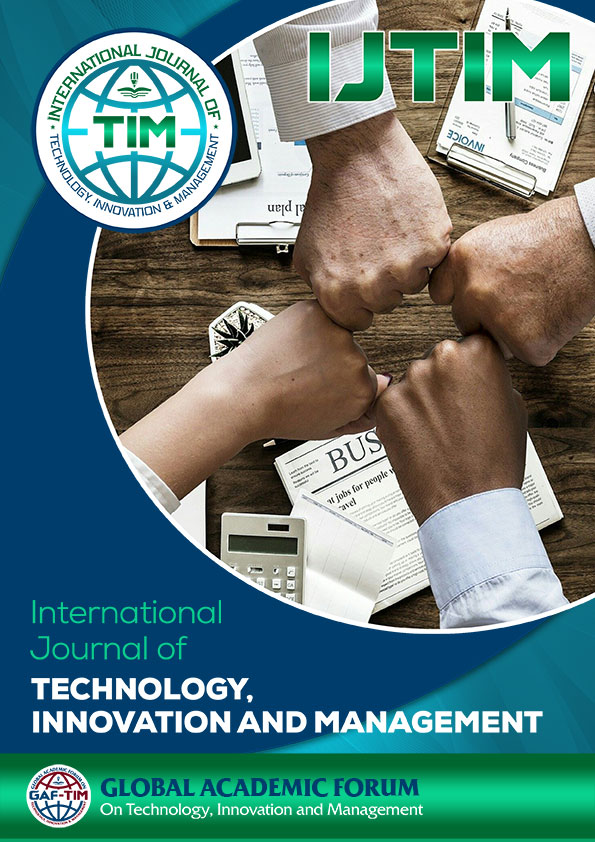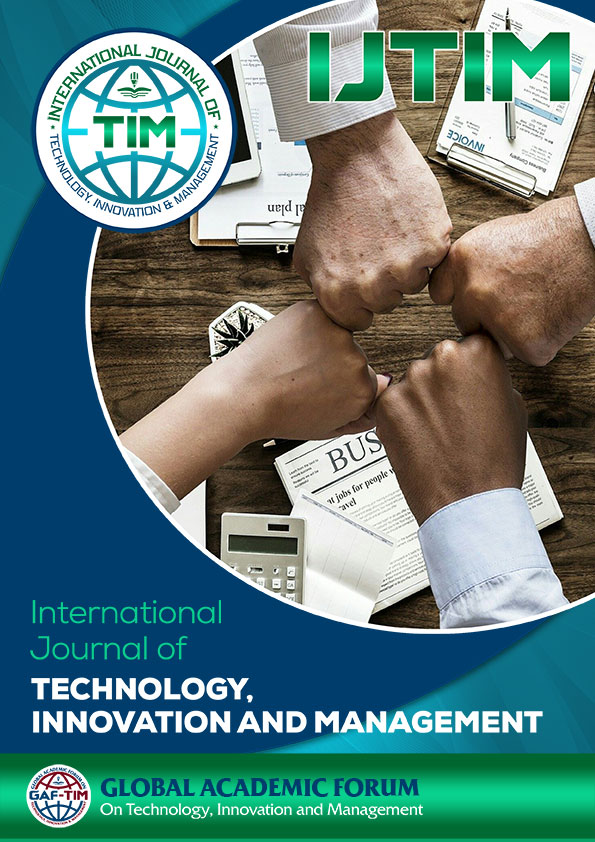Beyond Brick and Mortar: Unveiling the Willingness to Adopt E-Banking Services
DOI:
https://doi.org/10.54489/0kgj6523Keywords:
UTAUT, Palestine, Bank services, e-banking, intention to useAbstract
The banking sector is one of the most essential sectors for the Palestinian economy. Therefore, many researchers are examining recent developments in banking services and clients' attitudes toward accepting or rejecting technological developments in these services and their transformation from traditional services to electronic banking services. This research explores the relationship between performance expectancy, effort expectancy, social influence, perceived risk, and consumer attitudes toward accepting and adopting electronic banking services. It also examined the mediating effect of consumers' attitudes on the relationship between the sum of independent and dependent variables.
This study extends the UTAUT framework by implementing it with two additional factors, which are perceived risk as an independent variable and consumer attitude as a mediating variable. We constructed a conceptual model and employed Smart-Pls 3 to conduct structural equation modeling analyses. We implemented a survey-based methodology. A convenience sample technique was followed, and 306 bank customers in Palestine were surveyed using structured questionnaires.
The results indicate that Palestinian consumers' acceptance of using electronic banking services is significantly influenced by their attitude toward these services, their expectations, and the availability of facilitating conditions. Furthermore, consumer attitudes are approved to have a positive mediating effect in these relationships.
References
Afshan, S., Sharif, A., Waseem, N., & Frooghi, R. J. I. J. o. B. I. S. (2018). Internet banking in Pakistan: An extended technology acceptance perspective. 27(3), 383-410. DOI: https://doi.org/10.1504/IJBIS.2018.089863
Ajzen, I. J. J. o. a. s. p. (2002). Perceived behavioral control, self‐efficacy, locus of control, and the theory of planned behavior 1. 32(4), 665-683. DOI: https://doi.org/10.1111/j.1559-1816.2002.tb00236.x
Akbar, N. J., Radha, C. M., Subramani, A. K., & Sasikala, M. S. J. S. J. o. M. (2020). Examining the factors influencing adoption of e-banking services in Chennai City. 15, 181-192. DOI: https://doi.org/10.5937/sjm15-20323
Akhtar, N., & Khawaja, K. F. J. J. o. M. S. (2018). Investigating Mobile Learning Acceptance in Pakistan: The Moderating Effect of Discomfort and Insecurity in Unified Theory of Acceptance and Use of Technology. 12(1).
Alduais, F., & Al-Smadi, M. O. J. E. (2022). Intention to Use E-Payments from the Perspective of the Unified Theory of Acceptance and Use of Technology (UTAUT): Evidence from Yemen. 10(10), 259. DOI: https://doi.org/10.3390/economies10100259
Ali, J. J. T. J. o. D. A. (2023). Factors Affecting the Adoption of Digital Banking Services in India: Evidence from World Bank's Global Findex Survey. 57(2), 341-353. DOI: https://doi.org/10.1353/jda.2023.0037
Alshehri, M., Drew, S., Alhussain, T., & Alghamdi, R. J. a. p. a. (2012). The Effects of Website Quality on Adoption of E-Government Service: AnEmpirical Study Applying UTAUT Model Using SEM.
Alturas, B. J. R. A. i. T. A. M., & Theories. (2021). Models of acceptance and use of technology research trends: Literature review and exploratory bibliometric study. 13-28. DOI: https://doi.org/10.1007/978-3-030-64987-6_2
Aviyanti, R. D., Saraswati, E., Prastiwi, A. J. T. I. J. o. A., & Society, B. (2021). Analysis of acceptance of accounting information system implementation based on electronic payment using the UTAUT model. 29(2), 119-149. DOI: https://doi.org/10.21776/ub.ijabs.2021.29.2.8
Benitez, J., Henseler, J., Castillo, A., & Schuberth, F. (2019). How to perform and report an impactful analysis using partial least squares: Guidelines for confirmatory and explanatory IS research. Information & Management. DOI: https://doi.org/10.1016/j.im.2019.05.003
Çelik, Z., & Uslu, A. J. Ö. D. (2022). A BIBLIOMETRIC ANALYSIS OF THE LITERATURE ON THE ORIGINS OF THE TECHNOLOGY ACCEPTANCE MODEL (TAM) AND A MARKETING-SIDED APPROACH TO TAM. DOI: https://doi.org/10.14783/maruoneri.1171625
Chang, S.-J., Hsu, C.-I., Lin, C.-T. J. J. o. I., & Systems, F. (2020). Using FAHP and CBR to evaluate the intention of adoption of internet banking service: The example of web ATM. 39(3), 2869-2879. DOI: https://doi.org/10.3233/JIFS-191408
Chofa, S., Cooharojananone, N., & Phimoltares, S. (2012). The new screen design for the internet banking websites in Thailand (case study: university student). 2012 Ninth International Conference on Computer Science and Software Engineering (JCSSE), DOI: https://doi.org/10.1109/JCSSE.2012.6261959
Collerette, P., Legris, P., & Manghi, M. J. J. o. C. M. (2006). A successful IT change in a police service. 6(2), 159-179. DOI: https://doi.org/10.1080/14697010600694259
Federal Reserve Board. (2001). The E-Banking Report: The Risks and Opportunities of Internet Financial Services. F. R. Board. https://www.federalreserve.gov/boarddocs/rptcongress/ebanking/2001/default.htm
Hair, J. F., Howard, M. C., & Nitzl, C. (2020). Assessing measurement model quality in PLS-SEM using confirmatory composite analysis. Journal of Business Research, 109, 101-110. https://doi.org/https://doi.org/10.1016/j.jbusres.2019.11.069 DOI: https://doi.org/10.1016/j.jbusres.2019.11.069
Hair, J. F., Ringle, C. M., & Sarstedt, M. (2011). PLS-SEM: Indeed a Silver Bullet. Journal of Marketing Theory and Practice, 19(2), 139-152. https://doi.org/10.2753/MTP1069-6679190202 DOI: https://doi.org/10.2753/MTP1069-6679190202
Hennington, A., & Janz, B. D. J. C. o. t. A. f. I. S. (2007). Information systems and healthcare XVI: physician adoption of electronic medical records: applying the UTAUT model in a healthcare context. 19(1), 5. DOI: https://doi.org/10.17705/1CAIS.01905
Holden, R. J., Karsh, B.-T. J. B., & Technology, I. (2009). A theoretical model of health information technology usage behaviour with implications for patient safety. 28(1), 21-38. DOI: https://doi.org/10.1080/01449290601138245
Holtz, B., & Krein, S. J. J. o. T. i. H. S. (2011). Understanding nurse perceptions of a newly implemented electronic medical record system. 29(4), 247-262. DOI: https://doi.org/10.1080/15228835.2011.639931
Indriyarti, E. R., Christian, M., Yulita, H., Aryati, T., & Arsjah, R. J. J. J. o. D. S. (2023). Digital bank channel distribution: Predictors of usage attitudes in Jakarta’s gen Z. 21(2), 21-34.
International Monetary Fund. (2003). E-Banking: Challenges and Opportunities. https://www.imf.org/external/pubs/ft/issues/issues27/index.htm
Kijsanayotin, B., Pannarunothai, S., & Speedie, S. M. J. I. j. o. m. i. (2009). Factors influencing health information technology adoption in Thailand's community health centers: Applying the UTAUT model. 78(6), 404-416. DOI: https://doi.org/10.1016/j.ijmedinf.2008.12.005
Kwarteng, M., Plata, D., Ratilla, M., Novak, P., & Zlamal, L. J. S. J. o. M. (2022). Extending the UTAUT model to understand the barriers towards SME digitalization in the Czech Republic. 17(2), 403-424. DOI: https://doi.org/10.5937/sjm17-37629
Lee, J.-M., Lee, B., & Rha, J.-Y. J. I. J. o. E. C. S. (2019). Determinants of mobile payment usage and the moderating effect of gender: Extending the UTAUT model with privacy risk. 10(1), 43-64. DOI: https://doi.org/10.7903/ijecs.1644
Lichtenstein, S., & Williamson, K. J. J. o. e. c. r. (2006). Understanding consumer adoption of internet banking: an interpretive study in the Australian banking context. 7(2), 50.
Meuter, M. L., Ostrom, A. L., Bitner, M. J., & Roundtree, R. J. J. o. B. R. (2003). The influence of technology anxiety on consumer use and experiences with self-service technologies. 56(11), 899-906. DOI: https://doi.org/10.1016/S0148-2963(01)00276-4
Nguyen, T. T., Nguyen, H. T., Mai, H. T., Tran, T. T. M. J. A. E., & Review, F. (2020). Determinants of digital banking services in Vietnam: Applying utaut2 model. 10(6), 680. DOI: https://doi.org/10.18488/journal.aefr.2020.106.680.697
Palestine Monetary Authority. (2022). Annual Report 2022. https://www.pma.ps/Portals/0/Users/002/02/2/Publications/English/Annual%20Reports/PMA%20Annual%20Reports/Annual%20Report%202022.pdf?ver=2023-07-30-153124-557×tamp=1690720257310
Palestine Monetary Authority. (2023). Financial Inclusion Diagnostic Report – A Summary. 37. https://www.financialinclusion.ps/cached_uploads/download/2023/11/05/financial-inclusion-diagnostic-report-1699177748.pdf
Palestinian Central Bureau of Statistics. (2020). Household Survey on Information and Communications Technology, 2019. P. C. B. o. Statistics.
Pavlou, P. A., Liang, H., & Xue, Y. J. M. q. (2007). Understanding and mitigating uncertainty in online exchange relationships: A principal-agent perspective. 105-136. DOI: https://doi.org/10.2307/25148783
Putra, A. H., Dwi, L., Halianto, Y., Nur, C., Engineering, D. J. P. o. t. I. C. o. I., & Management, O. (2023). Factors Affecting Intention to Use on the Digital Banking Services Offered by Digital Banks in Indonesia.
Rana, N. P., & Dwivedi, Y. K. J. G. I. Q. (2015). Citizen's adoption of an e-government system: Validating extended social cognitive theory (SCT). 32(2), 172-181. DOI: https://doi.org/10.1016/j.giq.2015.02.002
Rastogi, G., Verma, H., & Sushil, R. J. S. J. o. M. (2018). Determining factors influencing cloud services adoption in India. 13(2), 335-352. DOI: https://doi.org/10.5937/sjm13-13207
Sarstedt, M., & Cheah, J.-H. (2019). Partial least squares structural equation modeling using SmartPLS: a software review. Journal of Marketing Analytics, 7(3), 196-202. https://doi.org/10.1057/s41270-019-00058-3 DOI: https://doi.org/10.1057/s41270-019-00058-3
Sarstedt, M., Ringle, C. M., & Hair, J. F. (2017). Partial least squares structural equation modeling. Handbook of market research, 1-40. DOI: https://doi.org/10.1007/978-3-319-05542-8_15-1
Savić, J., & Pešterac, A. J. T. E. j. o. a. e. (2019). Antecedents of mobile banking: UTAUT model. 16(1). DOI: https://doi.org/10.5937/EJAE15-19381
Sheng, Z., Wang, Z., Qiu, C., Li, L., Pang, A., Wu, A., . . . Gan, F. J. I. P. J. (2012). A compact and low-loss MMI coupler fabricated with CMOS technology. 4(6), 2272-2277. DOI: https://doi.org/10.1109/JPHOT.2012.2230320
Sun, Y., Wang, N., Guo, X., & Peng, Z. J. J. o. e. c. r. (2013). Understanding the acceptance of mobile health services: a comparison and integration of alternative models. 14(2), 183.
Teo, T., & Noyes, J. J. I. L. E. (2014). Explaining the intention to use technology among pre-service teachers: a multi-group analysis of the Unified Theory of Acceptance and Use of Technology. 22(1), 51-66. DOI: https://doi.org/10.1080/10494820.2011.641674
Tetteh, J. E. J. J. o. I. C. (2022). Electronic banking service quality: Perception of customers in the Greater Accra region of Ghana. 21(1), 104-131. DOI: https://doi.org/10.1080/15332861.2020.1870340
Tomić, N., Kalinić, Z., & Todorović, V. J. P. E. J. (2023). Using the UTAUT model to analyze user intention to accept electronic payment systems in Serbia. 22(2), 251-270. DOI: https://doi.org/10.1007/s10258-022-00210-5
Venkatesh, V., & Bala, H. J. D. s. (2008). Technology acceptance model 3 and a research agenda on interventions. 39(2), 273-315. DOI: https://doi.org/10.1111/j.1540-5915.2008.00192.x
Venkatesh, V., Morris, M. G., Davis, G. B., & Davis, F. D. J. M. q. (2003). User acceptance of information technology: Toward a unified view. 425-478. DOI: https://doi.org/10.2307/30036540
Voorhees, C. M., Brady, M. K., Calantone, R., & Ramirez, E. (2016). Discriminant validity testing in marketing: an analysis, causes for concern, and proposed remedies. Journal of the Academy of Marketing Science, 44(1), 119-134. https://doi.org/10.1007/s11747-015-0455-4 DOI: https://doi.org/10.1007/s11747-015-0455-4
Wills, M. J., El-Gayar, O. F., & Bennett, D. (2008). Examining healthcare professionals' acceptance of electronic medical records using UTAUT.
Wong, K. K.-K. (2013). Partial least squares structural equation modeling (PLS-SEM) techniques using SmartPLS. Marketing Bulletin, 24(1), 1-32.
Zin, K. S. L. T., Kim, S., Kim, H.-S., & Feyissa, I. F. J. A. S. (2023). A Study on Technology Acceptance of Digital Healthcare among Older Korean Adults Using Extended Tam (Extended Technology Acceptance Model). 13(2), 42. DOI: https://doi.org/10.3390/admsci13020042















